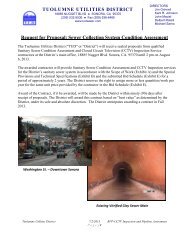Historic Resource Evaluation Project - Tuolumne Utilities District
Historic Resource Evaluation Project - Tuolumne Utilities District
Historic Resource Evaluation Project - Tuolumne Utilities District
Create successful ePaper yourself
Turn your PDF publications into a flip-book with our unique Google optimized e-Paper software.
sparsely or intermittently; new settlements were located higher in the mountains.<br />
Trade with peoples to the west was disrupted; the bow and arrow were<br />
introduced; exotic artifacts . . . were buried with the dead; and violence was<br />
commonplace... . Archaeologically, this disquieting episode is recorded as the<br />
Early Kings Beach, Redbud, Tamarack [and other] phases.<br />
♦ New levels of population growth and social integration were achieved after . . .<br />
1400-1500. This resulted in part from movements into the Sierra of new<br />
populations, notably the Miwok . . . and Mono...<br />
♦ ... as a result of Ibero-American incursions and pressures, Indians from western<br />
California sought refuge in the Sierra... after A. D. 1770. ... The epidemic of 1833<br />
devastated foothill Indians and left many of their villages deserted forever... . The<br />
Gold Rush of circa 1848-1860 severely disrupted settlements in the Mother Lode<br />
country and often triggered the relocation of entire villages... . Finally, the<br />
establishment of ... reservations ... further coalesced Indian groups, reduced their<br />
numbers, and accelerated cultural and social changes. All of this has resulted in<br />
an archaeological record of singular complexity in the Sierra Nevada [Moratto<br />
1984:337-338].<br />
Culture Chronology. Chronological sequences for the central Sierra Nevada have<br />
utilized the cultural chronologies developed during the New Melones Archaeological<br />
<strong>Project</strong> (Moratto et al. 1988) and from the Yosemite studies such as Bennyhoff (1956)<br />
and Hull et al. (1998). While these two culture chronologies do not agree with each other<br />
in every detail, there is more or less agreement on the timing of each temporal phase.<br />
The project area is closest to the Stanislaus River where the New Melones sequence was<br />
developed. From ca. 9600 B.P. to 6800 B.P., the Clarks Flat Phase was identified at CA-<br />
CAL-S342, which included bipointed, foliate, and stemmed points, scrapers, notched<br />
tools and beaked gravers. Later in the phase, milling slabs, manos, many types of<br />
scrapers, and Western Stemmed Series points were added to the artifact inventory. The<br />
Stanislaus Phase from 8000 - 5500 B.P., Pinto and Humboldt series projectile points<br />
occur along with the later Clarks Flat artifact types and Stanislaus Broad Stemmed<br />
points. The increasing diversity of artifact types is thought to reflect increasing levels of<br />
occupation and economic pursuits compared to the limited and temporary use of sites in<br />
the Clarks Flat Phase interpreted as hunting camps. From 5500 - 4500 B.P., the Texas<br />
Charley Phase’s large lanceolate bifaces and distinctive scrapers were followed by the<br />
Calaveras Phase spanning from 4000 - 3000 B.P. This time period seemed to indicate an<br />
abandonment of the area with few remains of Pinto and Humboldt series points and<br />
milling stones found. The following time period signaled a re-occupation of the area<br />
from 3000 - 1500 B.P. with the introduction of the bowl mortar, cylindrical pestle, points<br />
including Elko series, Sierra Concave Base and Sierra Side-Notch, large populations,<br />
houses, middens, cemeteries, trade, Olivella F and G beads, economic diversity, and<br />
acorn use. This was followed by another sparse usage time period, the Redbud Phase<br />
from 1500 - 650 B.P., characterized by Rosegate series points, and Olivella D, K, and M<br />
beads. At approximately 500 A.D., there is a general agreement of a rather major change<br />
in subsistence technology in the central Sierra. <strong>Project</strong>ile points changed from larger,<br />
heavier points presumably used with atlatls and darts, to smaller points probably<br />
indicating a change to the use of the bow and arrow. Processing of vegetable foods<br />
changed from milling with a mano and metate (millingstone) to mortar and pestle. It is<br />
thought that this technological change also indicates a food preference change from seeds<br />
to acorns, although there is now evidence that mortars and pestles were used for<br />
Foothill <strong>Resource</strong>s, Ltd. 1.6 TUD Ditch Sustainability <strong>Project</strong><br />
Francis Heritage, LLC<br />
<strong>Historic</strong> <strong>Resource</strong> <strong>Evaluation</strong> Report




